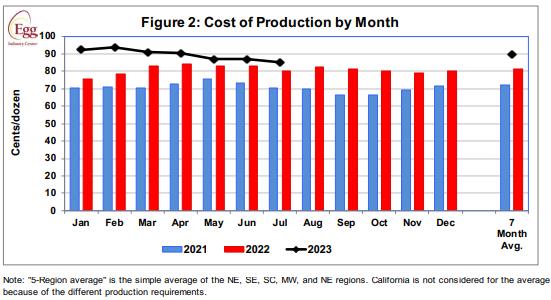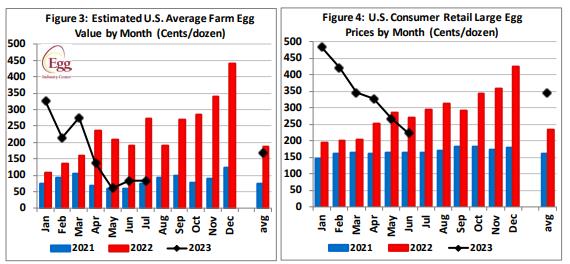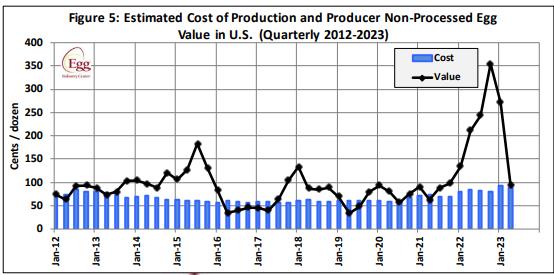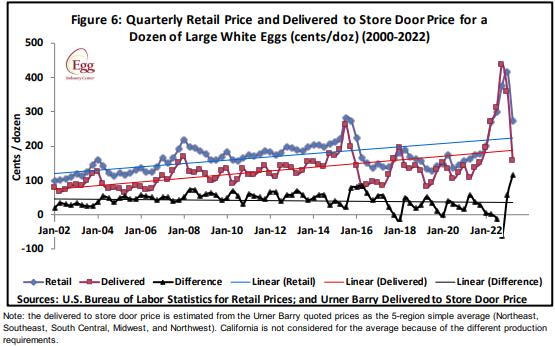REVIEW OF JULY 2023 EGG PRODUCTION COSTS AND STATISTICS.
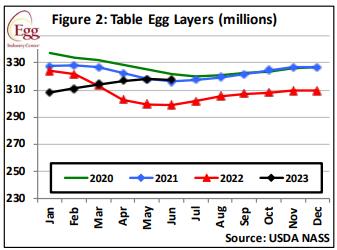
JUNE HIGHLIGHTS
- July 2023 USDA ex-farm blended USDA nest-run benchmark price was 82.9 cents per dozen, up 0.9 percent from the June 2023 value of 82.2 cents per dozen. For comparison average USDA benchmark price over 2022 was 236.1 cents per dozen with a range of 191.1 cents per dozen in June to a high of 439.1 cents in December. Stock levels and prices prior to the onset of flock depletion due to HPAI indicated a relative seasonal balance between supply and demand. Future wholesale prices will be largely dependent on consumer demand in an inflationary and price conscious environment. Other considerations include diversion to shell sales from the egg-breaking sector. Fluctuation in wholesale price is attributed in part to the amplification of upward and downward swings due to the price discovery system in use. A significant decline from 1st Quarter 2023 values but consistent with the 2nd Quarter is anticipated through summer months of 2023 given the prolonged plateau in benchmark price.
- July 2023 USDA average nest-run production cost, applying updated inputs was down 1.7 cents per dozen (2.0 percent, rounded) to 85.2 cents per dozen compared to the June 2023 value of 86.9 cents per dozen, mainly attributable to a 3.3 percent lower average feed cost per dozen.
- July 2023 USDA benchmark nest-run margin attained a negative value of (2.3) cents per dozen compared to a negative margin of (4.7) cents per dozen for June 2023. Average nest-run monthly margin over 2022 was 155 cents per dozen.
- The June 2023 national flock in production (over 30,000 hens/farm) was down 0.1 percent or 0.4 million hens (rounded) to 300.6 from the May 2023 value of 301.0 million. Approximately 3.5 million hens returned to production from molt in July together with projected maturation of 22.0 million pullets, with this number offset by depletion of spent flocks. From February through mid-December 2022, approximately 44 million hens were depopulated to control HPAI during spring and fall waves reducing the producing flock by an approximate constant weekly average of 20 million hens during 2022.
- June 2023 pullet chick hatch of 28.7 million was down 2.4 percent or 0.8 million from May 2023.
- June 2023 exports of shell eggs and products combined were down 26.2 percent from May 2023 to 545,000 case equivalents representing the theoretical production of 7.8 million hens.
TABLES SHOWING KEY PARAMETERS FOR JULY 2023.
Summary tables for the latest USDA July 2023 prices and flock statistics made available by the EIC on August 11th 2023 are arranged, summarized, tabulated and compared with values from the previous July 10th 2023 posting reflecting May and June 2023 costs and production data as applicable.
COSTS & REVENUE
|
Parameter
|
JULY 2023
|
JUNE 2023
|
|
5-Region Cost of Production ex farm (1st Cycle)1
|
85.2 c/doz
|
86.9 c/doz
|
|
Low
|
82.1c/doz (MW)
|
83.7 c/doz (MW)
|
|
High
|
93.1 c/doz (N.West)
|
94.0c/doz (N.West)
|
Components of USDA 6-Region 1stCycle nest-run Cost of Production updated by the EIC in May 2023 following an industry survey:-
Note: 1. Rounded to decimal of a cent
| |
JULY 2023
|
JUNE 2023
|
|
Feed
|
45.7 c/doz
|
47.3c/doz
|
|
Pullet depreciation
|
12.7 c/doz
|
12.8 c/doz
|
|
Labor (estimate) plus
|
|
|
|
Housing (estimate) plus
|
26.9c/doz1
|
26.8c/doz
|
|
Miscellaneous and other*
|
|
|
* Adjusted May 2023
Ex Farm Margin (rounded to nearest cent) according to USDA values reflecting JULY 2023:-
82.9 cents per dozen1- 85.2 cents per dozen =(2.3) cents per dozen (June 2023 comparison: 82.2 cents per dozen – 86.9 cents per dozen = (4.7) cents per dozen.)
Note 1: USDA Blended egg price
| |
|
JULY 2023
|
JUNE 2023
|
|
USDA
|
Ex-farm Price (Large, White)
|
82.9 c/doz (July)
|
82.2c/doz (June)
|
| |
Cage-free to packing plant1
|
120.0 c/doz (July)
|
100.0 c/doz (June)
|
| |
Warehouse/Dist. Center
|
118.3 c/doz (July)
|
118.0 c/doz (June)
|
| |
Store delivered (estimate)
|
123.3 c/doz (July)
|
123.0 c/doz (June)
|
| |
Dept. Commerce Retail
|
221.9 c/doz (June)
|
266.0c/doz (May)
|
Negotiated price, nest-run loose
MONTH JULY 2023 JUNE 2023
U.S. Average Feed Cost per ton $283.09 $292.66
Low Cost Midwest $265.46 $274.69
High Cost Northwest $326.74 $332.07
Differential $ 61.28 $ 57.38
Pullet Cost*
(19 Weeks) $4.97 JULY 2023 $5.04 JUNE 2023
(16 weeks) $4.34 JULY 2023 $4.40 JUNE 2023
* Values adjusted by EIC in May 2023
VOLUMES OF PRODUCTION
|
PARAMETER
|
JULY 2023
|
JUNE 2023
|
|
Table-egg strain eggs in incubators
|
49.1 million (July)
|
55.5* million (June)
|
|
Pullet chicks hatched
|
28.7 million (June)
|
29.4* million (May)
|
|
Pullets to be housed 5 months after hatch
|
25.9 million (Nov.)
|
26.6 million (Oct.)
|
|
EIC 2023 December 1st Flock Projection
|
332.4 (Aug.)
|
333.4 million (July)
|
|
National Flock in farms over 30,000
|
300.6 million (June)
|
301.0 million (May)
|
|
National egg-producing flock
|
317.6 million (June)
|
318.2* million (May)
|
|
Cage-free flock excluding organic
|
103.0 million (July)
|
103.4 million (June)
|
|
Proportion of flocks in molt or post-molt
|
13.2% (July)
|
12.8% (June)
|
|
Total of hens in National flock, 1st cycle (estimate)
|
275.6 million (June)
|
277.3 million (May)
|
* USDA Revision
|
Total U.S. Eggs produced (billion)
|
7.77 JUNE
|
8.02 MAY
|
|
Total Cage-Free hens in production
|
121.2 million (July)
15.0% Organic
|
121.6 million (June)
15.0% Organic
|
|
“Top-5” States hen population (USDA)1
|
152.5* million (April)
|
152.7 million (May)
|
Notes 1. Texas excluded to maintain confidentiality
* USDA Revision
PROPORTION OF U.S. TOTAL HENS BY STATE, 20231
Based on a nominal denominator of 300 million hens in flocks over 30,000 covering 95.0 percent of the U.S complement.
USDA has amended inclusion of specific states in regions and eliminated Texas data to protect confidentiality of Company flock
Sizes
|
STATE
|
JUNE
2023
|
MAY
2023
|
|
|
Iowa
|
15.0%
|
15.0%
|
|
|
Indiana
|
11.7%
|
11.8%
|
|
|
Ohio
|
12.2%
|
12.3%
|
|
|
Pennsylvania
|
8.2%
|
8.0%
|
|
|
Texas (estimate)
|
7.3% ?
|
7.2%
|
|
|
California
|
3.6%
|
3.7%
|
|
- Values rounded to 0.1%
Rate of Lay, weighted hen-week (USDA) 81.9% July 2023. 81.3% JUNE 2023
Revised per capita egg consumption 2019:- 293.4 (up 5.6 eggs from 2018)
Revised per capita egg consumption 2020:- 285.6 (down 7.8 eggs from 2019)*
Revised per capita egg consumption 2021:- 282.5 (down 3.1 eggs from 2020)*
Revised per capita egg consumption 2022:- 279.0 (down 3.5 eggs from 2021 due to HPAI) Projected per capita egg consumption 2023:- 282.5 (up 3.5 eggs from 2022) Forecast per capita egg consumption 2024 292.7 (up 10.2 eggs from 2023 assuming no HPAI)
*Revised, using data from USDA Livestock, Dairy and Poultry Outlook July 12th 2023 taking into account demand from the food service sector and including the effect of HPAI depopulation.
Egg Inventories at beginning of JULY 2023:
Shell Eggs: 1.69 million cases down 5.6 percent from June 2023.
Frozen Egg Products: 705,172 case equivalents down 10.3 percent from June 2023
Dried Egg Products: Not disclosed since March 2020 following market disruption due to COVID. Assume moderate level of inventory
Eggs broken under FSIS inspection (million cases)
JUNE 2023, 6.32 MAY 2023, 6.46
Cumulative eggs broken under FSIS inspection 2022 (million cases) 79.3 JAN. to DEC.
Cumulative 2022: number of cases produced (million) 257.3 JAN. to DEC.
Cumulative 2022: proportion of total eggs broken 30.8% (28.9% 2021)
Cumulative 2023: number of cases produced (million) 128.4 JAN. – JUNE.
Cumulative 2023: proportion of total eggs broken 29.9%
EXPORTS JUNE 2023: (Expressed as shell-equivalent cases of 360 eggs).
|
Parameter
|
Quantity Exported
|
|
Exports:
|
2023
|
|
Shell Eggs (thousand cases)
|
May 316 June 198
|
|
Products (thousand case equivalents)
|
May 428 June 347
|
|
TOTAL (thousand case equivalents)*
|
May 744 June 545
|
*Representing 2.5 percent of National production in JUNE 2023.
COMMENTARY ON JULY 2023 COSTS AND STATISTICS
COST AND REVENUE DATA FOR JULY 2023
The USDA reports data for five regions, respectively comprising the Northeast, South East (Mid-Atlantic), South Central, Midwest, and Northwest (NW and California combined in some tables).
From March 2019 onward some state data was withheld to maintain confidentiality where a company predominates in a specific state or region. From March 2021 California costs were inexplicably excluded, representing an unjustified concealment of data. The three Pacific Coast states could be combined to maintain confidentiality while providing representative U.S. data. Costs include fixed components (interest, depreciation and overhead) and variable components (feed, pullet depreciation, labor) recalculated in May 2023 by the EIC based on surveys
- The USDA ex farm benchmark blended egg price in July 2023 was less than 0.1 percent higher at 82.9 cents per dozen from the June 2023 value of 82.2 cents per dozen. This contributed to a negative margin of (2.3) cents per dozen based on ‘nest-run’ generic eggs (ungraded as delivered from the laying house) in July 2023, compared to a negative margin of (4.7) cents per dozen in June 2023. The July 2023 USDA benchmark price of 82.9 cents per dozen should be compared to 73.2 cents per dozen for the corresponding month in 2021 and 271.0 cents per dozen in June 2022 impacted by HPAI. The relatively high values from the second through fourth quarters of 2022 compared to corresponding periods for the two previous years were due to depletion of hens following the emergence of HPAI coupled with a rise in demand following relaxation of COVID restrictions and the amplification of price rises due to the benchmark costing system.
- During July 2023, the feed component of production cost averaged 45.7 cents per dozen, down 3.3 percent or 1.6 cents per dozen from June 2023. During 2022 average feed cost was 50.1 cents per dozen compared to 42.5 cents per dozen in 2021 and 31.7 cents per dozen in 2020.
- Combining data from the USDA and the EIC, producers recorded a negative margin of (2.3) cents per dozen at farm-level for generic-egg flocks during July 2023. This compares with a negative margin of (4.7) cents per dozen in June 2023. During 2022 cumulative algebraic margin attained 1,887 cents per dozen. For 2021 the cumulative average algebraic margin was 91.0 cents per dozen; for 2020, 16.0 cents; for 2019, (2.8) cents and for 2018, 35.3 cents per dozen, against USDA benchmark ‘nest run’ values.
- The simple average price of feed in July 2023 over 5-regions was $283.09 per ton, lower by $9.57 per ton or 3.3 percent compared to June 2023. Southwest data is no longer disclosed to avoid compromising a company that predominates in Texas. The highest cost among five regions was the Northwest at $326.04 per ton, down 1.6 percent from June 2023. This may be compared to the lowest-cost region, the Midwest at $265.46 per ton, down 3.4 percent from the previous month. The average cost for feed includes ingredients plus milling and delivery at a nominal $10 per ton.
- The benchmark price of corn was $217.14 per ton in July 2023, down $24.50 per ton or 10.0 percent from the average June 2023 price, taking into account the difference in basis paid by producers. The differential in corn price between the Midwest and the Northwest in July 2023 was $63.87 per ton. A 7.1 percent increase of $31.10 per ton in the price of soybean meal to $469.11 per ton in July 2023 offset the lower price of corn. During July 2023 there was a differential of $77.22 per ton in feed price between the Midwest and the Northwest compared to a difference of $57.38 per ton in June 2023 corresponding to 12.5 cents per dozen. The industry has experienced sharp increases in the cost of phosphate additives, fat and vitamins since March 2022.
- Feed price will continue to be a major factor driving production cost and hence margin. July WASDE #639 (in this edition) released on August 11th confirmed the volumes for the 2023 corn and soybean harvests, ingredient use, exports and ending stocks for the two major feed ingredients. Unknown factors influencing feed cost during the third and fourth quarters of 2023 will include the consequences of conflict in Ukraine with inevitable disruption in production and especially shipping through the Black Sea. This influence coupled with the projected large harvests in Brazil, notwithstanding drought, and demand by China will determine prevailing prices in international trade. The availability and hence prices of ingredients will also be influenced by weather conditions following the transition from a La Nina, in the second quarter of 2023, to become an El Nino event; the transitory May-June drought affecting early-planted corn and all soybeans in the Midwest; export volume from the U.S. and especially to China; diversion of corn to ethanol and soy oil to biodiesel; the remaining economic and logistic effects of COVID restrictions and inflation. There is obviously higher demand for ethanol with production projected by the U.S. Energy Information Administration at 970,000 barrels per day but with an average exceeding one-million barrels per day during the first half of 2023. Substantial exports of soybeans to China, during market year 2022/2023 is increasing domestic price and hence cost of egg production. Each $10 per ton difference in feed cost represents approximately 1.70 cents per dozen. A change of $1 per ton (2.8 cents per bushel) in the price of corn is reflected in a 0.11 cent per dozen change in production cost. A $10 per ton change in the price of soybean meal affects production cost by 0.35 cent per dozen.
- The EIC calculated the 5-Region adjusted total nest-run production cost in July to be 85.2 cents per dozen, 1.8 cents per dozen lower than May 2023. Production costs during July 2023 ranged from 82.1 cents per dozen in the Midwest up to 93.1 cents per dozen in the Northwest, higher than the Midwest region by 11.0 cents per dozen. During 2022 the average monthly cost of production was 81.0 cents per dozen.
Deletion of California data is considered a substantial deficiency of the EIC Report.
- Retail egg prices as determined by the Department of Commerce for June 2023 averaged 221.9 cents per dozen, down 44.7 cents per dozen or 16.7 percent, compared to May 2023 at 266.6 cents per dozen. During June 2021 and 2022 retail prices were respectively 164.2 and 270.7 cents per dozen. Through 2017 and 2021 average retail prices did not decline in proportion to ex-farm prices, allowing higher margins at retail, thereby depressing demand. Retailers have recently demonstrated some restraint in pricing possibly due to competition from deep discounters and club stores, despite sustained demand.
- June 2023 average retail markup on generic white Large was 88.1 percent based on a delivered-to-warehouse price of $1.18 per dozen and USDA Retail of $2.22 per dozen.
PRODUCTION DATA FOR JULY 2023
- According to USDA, the estimated average complement of U.S. hens in flocks over 30,000 during June 2023 amounted to 300.6 million, reflecting a net decrease in flock size by 0.4 million hens during the month. Routine depletion and also depopulation due to HPAI during 2022 was offset by pullet replacements and retained flocks. The average total U.S. flock including hens in molt on all farms counted by the USDA amounted to 317.6 million in June 2023. The average end-of-year flock sizes over the past seven years respectively were, 2014, (311 million); 2015, (291 million post-HPAI losses); 2016, (319 million); 2017, (329.6 million); 2018, (341.6 million); 2019, (341.6 million) and 2020, (325.5 million). The December 1st 2023 flock was projected to be 332.4 in August 2023 applying the EIC model. Flock size during 2022 was depressed by spring and fall waves of depopulation due to HPAI amounting to 44 million hens through mid-December 2022. With replacements, molting and delayed depopulation it is estimated that the national flock now comprises 5 to 6 million fewer hens each week than before the advent of HPAI. In the absence of a vaccine only effective biosecurity will protect flocks going forward.
- Pullet chick hatch attained 28.7 million in June 2023, down 0.8 million from May 2023. During the past quarter seasonal egg prices have been considerably lower than before the 2022 HPAI epornitic, resulting in decreased demand for chicks.
- The total in-molt and post-molt population of hens in the 5-Regions monitored by the USDA attained 13.2 percent of the national flock in July 2023, up 0.4 percent from the previous month. Annual averages for molt and post-molt combined were 14.4 percent in 2021, 13.5 percent for 2020, 15.2 percent for 2019 and 17.4 percent for 2018. The historical high value of 23.8 percent in 2016 was due to the loss of hens during the 2015 HPAI epornitic. This situation will not be revisited in 2023.
- During the first quarter of 2023 the average monthly transfer of pullets to laying houses was 23.5 million to be followed by 20.8 million in the second quarter and 24.5 million in the third quarter. November 2023 transfer is projected at 25.9 million pullets.
- The projected hatchery supply flock (parent generation) peaked during 2022 at 3.1 million hens in June. The previous high parent-flock of 3.1 million hens in production was in June 2015, coinciding with the end of the HPAI epornitic. Parent hens then declined to a low of 2.5 million during the fourth quarter of 2016. During 2023 the flock size for parent hens will average 2.5 million over the fourth quarter. The size of the parent flock is unlikely to be revised based on pullet chick orders influenced by the demand to replace depopulated hens and in response to possible higher producer margins. It is understood that production of additional pullet chicks is unlikely given forward planning by breeder-hatcheries and full utilization of facilities.
- Average hen-week production of 81.9 percent in July 2023 compared to a revised value of 81.4 percent in June 2023 reflects a lower proportion of older hens in the national flock with many first-cycle hens and early second-cycle hens in production. Average rate of lay in 2021 was 82.0 percent, with 80.9 percent in 2020 and compared to 79.2 percent during 2019. The average rate of lay during any period is a function of the proportion of pullets placed, the rate of depletion of flocks and retention of molted hens for a second cycle. Average flock production declines as the weighted flock age increases or conversely will rise due to early depletion thereby increasing the proportion of young hens in their first cycle.
- The June 25th edition of the USDA Poultry Slaughter Report documented 3.1 million light spent-hens processed under FSIS inspection during June 2023, 0.3 percent less than during the previous month of May 2023 and 0.6 percent more than in June 2022. These differences are inconsequential in comparison to the depletion of 15 million hens per month with most either rendered or consigned to landfills. Provided housing space is available, prevailing high prices will result in retention of hens with fewer routine or previously scheduled flock depletions.
EXPORT DATA FOR JUNE 2023.
- Monthly export data can be accessed in the relevant report posted in this edition and thereafter through mid-July under the STATISTICS Tab.
- According to USDA-FAS data, 198,000 cases of shell eggs were exported in June 2023, representing 0.9 percent of total production. This was a 37.3 percent decrease compared to May 2023 despite lower prices. The decline in exports was attributed to the 106,000 lower export to Mexico.
- Exports of egg products in June 2023 attained 347,000 case-equivalents down 18.9 percent from the previous month, representing 1.6 percent of U.S. output.
- Collectively, exports of shell eggs and products in June 2023 comprised the output from approximately 7.8 million hens in production during the month, attaining 544,700 case-equivalents, down 26.7 percent from May 2023 and 8.6 percent less than combined exports during the pre-HPAI first quarter of 2022 averaging 596,300 case equivalents per month.
- Maintaining export volume is attributed to cooperation between the AEB and USAPEEC, in existing, new and potential markets. Specific attention is directed to nations with the potential to import U.S. product based on landed price against competition. Exports of both egg-products and shell eggs in May 2023 corresponded to 3.3 percent of a nominal national flock of approximately 301 million producing hens, (before HPAI depletions) on commercial farms holding more than 30,000 hens.
- There is no scientifically justifiable reason why any nation should embargo pasteurized egg products from an approved plant, based on a diagnoses of H5 or H7 avian influenza or velogenic Newcastle disease in a specific state or country.
